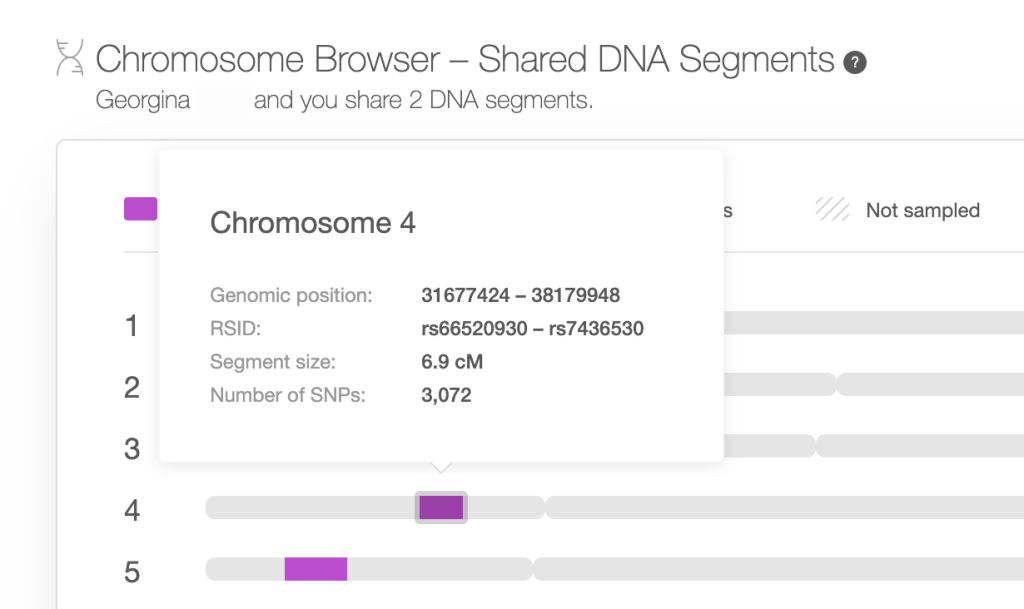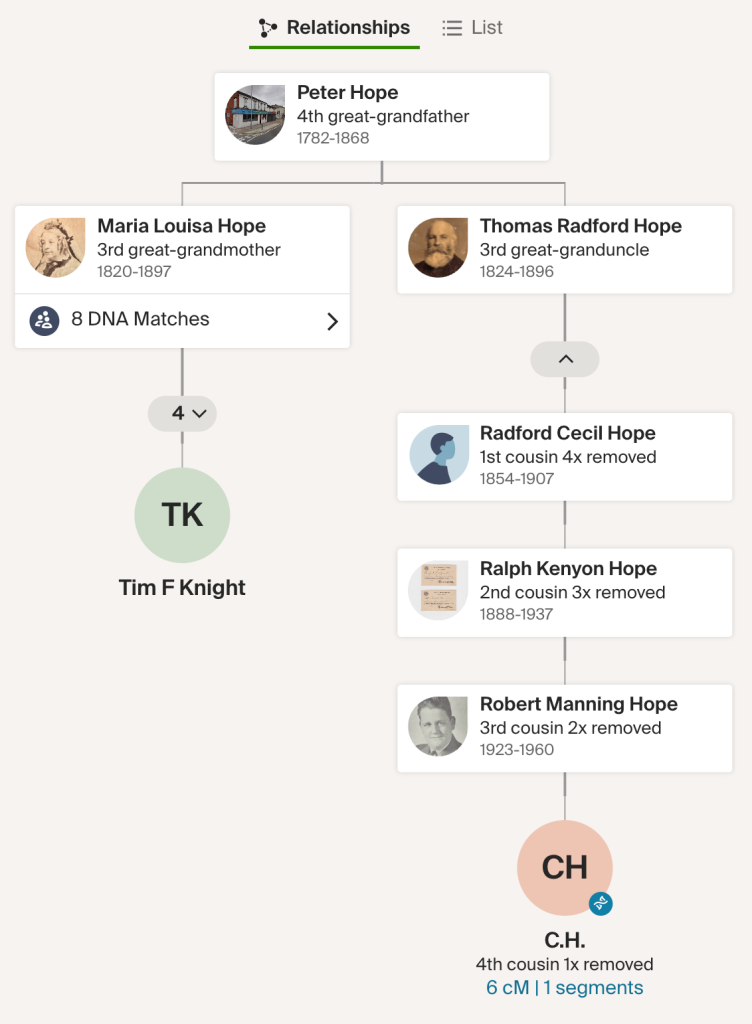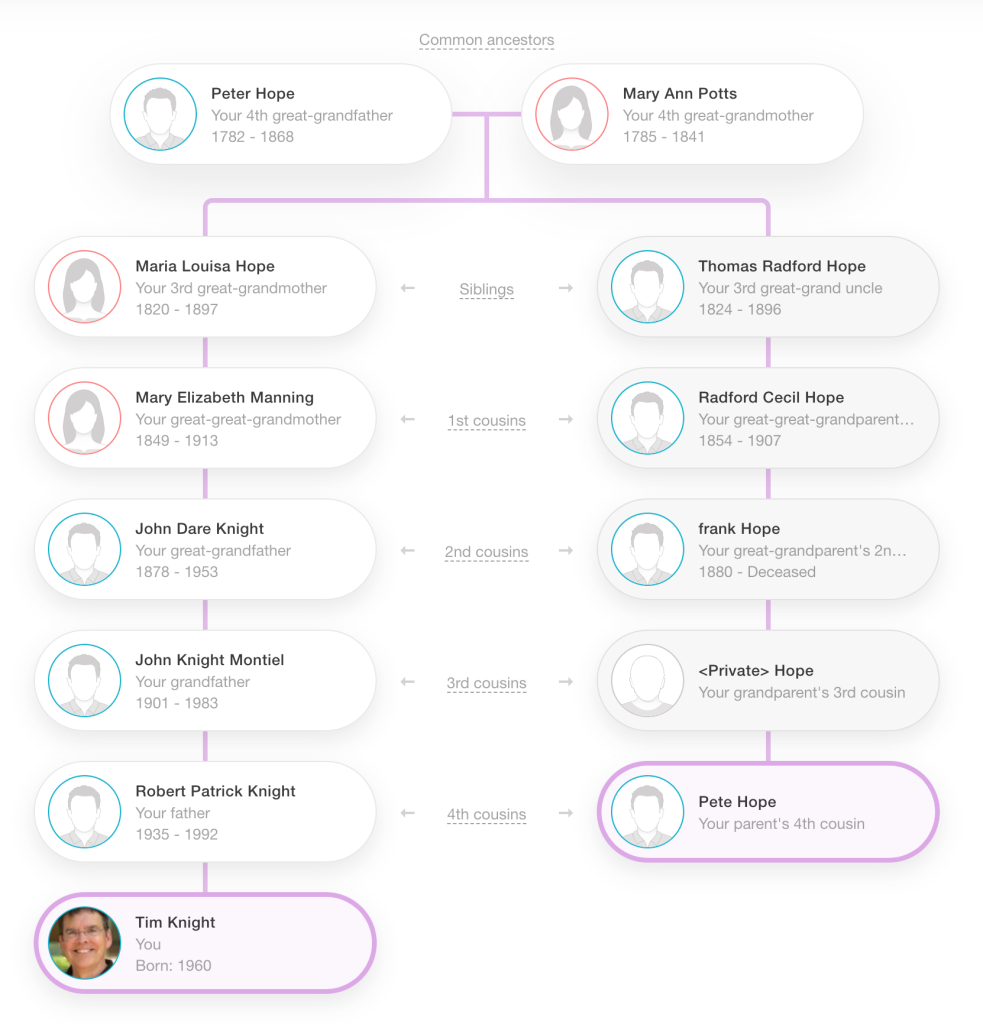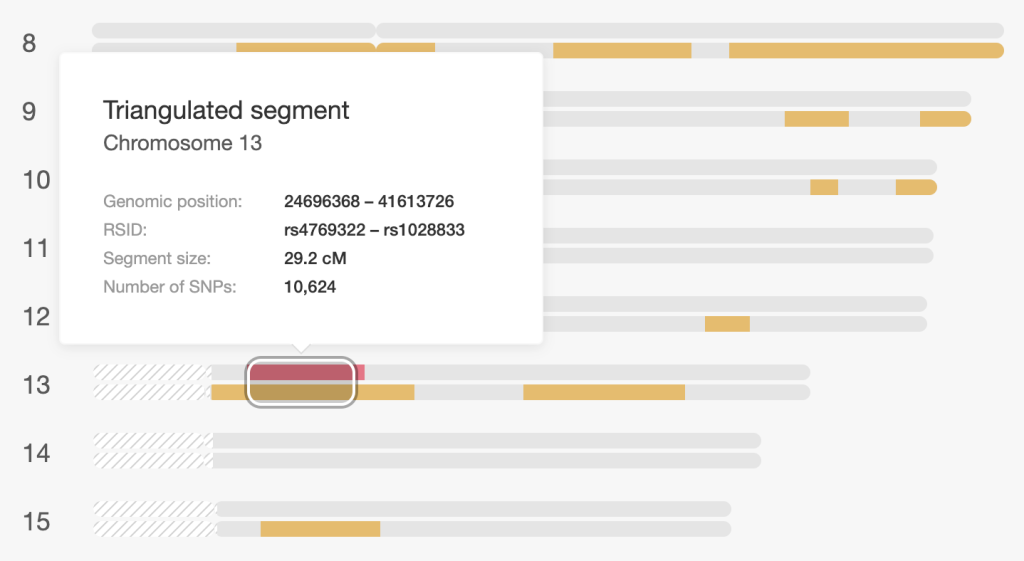Small DNA matches can lead to surprising results. But don’t be fooled, not all DNA matches are what they might seem.
This post focuses on finding Hope cousins around the world using a little genetic research to augment information provided by relatives on family lines connected to Peter Hope 1782-1868 a merchant of Liverpool.
It can take a lot of time to figure out a family connection based on small DNA matches. Often a small segment of DNA actually can be a false-positive (not a relative), so be careful. The DNA sequence might match by chance and not by family descent. The shared segment could be past down by a more distant ancestor than you might think.
What is a good DNA match?
You share around 50% of your DNA with your parents and children, 25% with your grandparents and grandchildren, and 12.5% with your cousins, uncles, aunts, nephews, and nieces. A match of 3% or more can be helpful for your genealogical research — but sometimes even less. Longer segments of shared DNA indicate that your common ancestor was probably more recent. (source: MyHeritage.com)
Small segments of matching DNA indicate connections to distant ancestors. The unit of DNA segments are referred to as centiMorgans (cM). My mum shares 3,444 cM or 50% shared DNA with me. While a 3rd cousin in England shares 75 cM and a distant cousin shares only 17 cM.
What is a CentiMorgan?
A centiMorgan (abbreviated cM) is a unit of measure for the frequency of genetic recombination.
Each individual has about 6,800 cM in total. Of these 6,800 they inherit about 3,400 or more from each parent.
Generally segments less than 6-8 cM are not trustworthy for genealogy purposes. Such segments are likely to be “false Positives”, meaning they look like real segments of DNA inherited from a shared ancestor (Called “identical by descent”, or IBD), but they’re not. (The DNA Geek)
Takeaway: A DNA match of 20+ cM is useful for genealogy research. Small DNA matches can give some useful insights, but be careful of false-positives.
What is considered a small DNA match?
10 centiMorgans (cM) or less is generally considered to be a small DNA match. Some people set the lower limit to 7 cM for a reliable match, but the false-positive rate is still about 10%. A 10 cM segment has a false-positive rate around 2%, so 98% could be considered real matches.
Someone who shares 10 cM of DNA might be 6th – 8th cousin, or more. Distant matches are 6 – 20 shared centimorgans on Ancestry.com
A match of 10 cM has a wide range of possible relationships. The connection may be within 8th-Great-Grandparent level, but the common ancestors could also be 20 or more generations back.
I noticed that my 20 cM shared matches sometimes include 2 segments of variable size. I found this recently with a double cousin, one segment was 12 cM and the other 8 cM – each matching to Czech relatives on paternal and maternal lines.
Where to begin…
What’s a good threshold to use for comparing shared DNA matches?
Look at DNA matches of 20 cM or greater to make it easier for making comparisons. This would be around 4th cousin – sharing 3rd Great-grandparents. Ancestry.com has a Close matches filter for selecting 20 – 3,490 shared centimorgans.
On Ancestry.com, my mom has 512 close matches (4 cousin or closer), while I have 370 close matches and that’s plenty to keep me busy. That’s certainly a lot of matches to evaluate, and unfortunately most don’t share family trees – making comparisons tricky.
Note: Distant matches (< 20 cM) often number in the thousands.
Tips
Building a family tree and making connections
Make sure to build out your family tree and include as much factual information as you can. Include grandparents and great-grandparents, with birth date and location, if known. Ask relatives to provide and verify family information. Research online resources like Find A Grave, WikiTree and NewsPapers.com for historical records.
When looking for relatives – start with the highest shared DNA matches. Look for family trees with 10 or more people, plus family photos and information. Searching for common surnames makes things easier.
DNA Testing
Encourage relatives to have their DNA tested on Ancestry or 23andMe. Then, recommend that they upload the raw DNA file to trusted websites to cast a bigger net. Read: Finding Cousins Using DNA Testing
Sharing Family Information
Setting up a simple family blog can be fun and a good investment of time and effort. It also helps for organizing photos and family details. Lots of relatives have read my blog and shared information about their families. Read more in Connecting with Cousins.
Finding Family Connections
Discovering my Hope family connections in America, UK, Mexico and beyond.
While looking through an old family tree I noticed that Hope was used as a middle name by a few families. So I did some research and discovered a connection with the prominent Hope families of Liverpool, England.
Peter Hope, my 4th great-grandfather, was a wine merchant and business owner in Liverpool. The first born son, George, became a successful doctor, while Thomas Radford Hope was a stock broker and business owner. Read about Peter Hope’s family.
I was hoping to connect with Hope relatives in the UK in order to learn more about the family line. Checking for DNA matches was a good option for making the family connection.
To increase the chances of finding a match to a Hope relative, I uploaded my Raw DNA file from Ancestry to Family Tree DNA, MyHeritage, and GEDmatch. Both MyHeritage and GEDmatch turned out to be the most useful resources for finding relatives in the UK and Europe. Plus, these resources have tools for finding shared matches, and making comparisons using triangulation too.
Using GEDmatch to find cousins
GEDmatch offers a free DNA site built for genetic genealogy research. Users can upload DNA files from different testing companies and find shared matches using a variety of tools. At first the website can seem overwhelming but there are some helpful tutorials on YouTube to get familiar with the comparison tools.
Start out simple by checking your shared DNA matches using …
One-To-Many DNA comparison tool – One-to-Many is the main tool you will use on GEDmatch to find your matches!
One-to-One Autosomal DNA Comparison – useful for finding matching segments of DNA
People who match both, or 1 of 2 kits – a favorite tool for discovering common matches among relatives
Note: I am thrilled if I find someone who shares 35 cM (1%) or more DNA. That’s in the 4th – 6th cousin range.
Finding relatives across the pond
Sometimes you need to look for small DNA matches to connect with a distant relative in the old country. Since my relatives left England long ago the closest matches are 3rd or 4th cousins – sharing 2nd or 3rd Great-grandparents. It’s more common for me to connect with 5th or 6th cousins, but these are really small DNA matches.
Examples of Knight cousins from England, with small matches.
Laura of London, 4th cousin (12 cM shared) on the Knight family line. Our most recent common relative is William Knight, soap maker of London, and 3rd Great-grandparent. Laura has a well researched family tree (1,800 people) carefully constructed using resources available in the UK. Our shared DNA match can be used as a reference for other possible Knight relatives in the UK. Laura shares 36 cM with distant cousin Nic and his son, and 12 cM with my daughter.
We visited The National Portrait Gallery together with her mum and sister to view old photos of our Knight relatives who met with the Royal family. We also viewed a classic oil painting of relative Samuel Bakewell, father of animal husbandry.
Georgina of London, 3rd cousin 1x removed (17 cM shared, 2 segments) Largest shared segment is 10 cM in MyHeritage. Related to Lady Constance Jane Knight – Georgina’s great-grandmother. Our common relative is William Knight, soap maker of London. Appears in a family tree with 3,000 people, many are known relatives. Shared DNA matches with 10+ relatives in my family tree.

Finding Hope around the world
My family tree includes hundreds of Hope relatives with roots in Scotland and England. During the pandemic, I tried to discover who left the UK and what motivated them to emigrate. Many of the families left for new opportunities, cheap land, or to join relatives in sunny places. A few families left England for adventure, health reasons, to avoid a scandal, or strike it rich.
Listed below are small DNA matches on the Hope family line who I have contacted and verified the connection. A few stories are included to provide interesting family history.
Hopes of England
Andy Hope of Liverpool, 4th cousin 1x removed (17 cM shared), also matches to two known cousins and my daughter. Family line traces back to George Henry Hope, MD who was the son of Peter Hope 1782-1868, a business owner in England.
G Hope Manning of Chester, 3rd cousin 1x removed (75 cM across 4 segments) Born in South Africa where some relatives still live. Verified all of the Hope and Manning relatives listed in the Manning family tree. Common relatives are Rev. Samuel Manning and Maria Louisa Hope of London, England. Maria was the daughter of Peter Hope, mentioned earlier. There are 14 shared matches on Ancestry.com
Kay B of Brentwood, 5th cousin (24 cM shared), with identical twin Lesley, who matches with G Hope Manning (3C 1R). 18,000 people in her family tree!
J Hodgkinson of Hampshire, 5th cousin (21 cM shared), matches with G Hope Manning. 10,000 people in family tree, including Hope surname.
Discovered several more distant cousins in England with 7 to 20 cM of shared DNA.
Hopes of America
C Hope, 4th cousin 1x removed (6 cM shared), our Hope family relationships are displayed in ThruLines on Ancestry (below). My Hope cousin matches with four known relatives tracing back to Peter Hope, 4th Great-Grandfather, who was a businessman of Liverpool, England. Common relatives were found in a huge family tree, containing valuable historical records, created by a genetics expert.

The small DNA match on chromosome 20 (6.8 cM and 1,556 SNPs) was confirmed using GEDmatch.

C Hope is the aunt of Johanna V, who shows a solid DNA match on the Hope line.
Johanna V, 5th cousin (44 cM shared, 2 segments), was found in a huge family tree. Her DNA matches with Peter Hope, shown below.
Peter Hope, 4th cousin 1x removed (31 cM shared), MyHeritage displays the correct family connection using Theory of Family Relativity (see below). I’m currently exploring his shared matches, including triangulation with known relatives. These tools are so useful!

Now, I plan on researching another branch of Hopes in America who were seeking to strike it rich during the gold rush. Learn about the Hopes of Horse Cove
Hopes of Mexico
Archibald Hope (1803–1871) Known as Archivaldo in Mexico, was born in Rainford, England. He was a very successful businessman – running woolen and cotton mills in Mexico. His relatives are shown below.
Juan Fernandez Sr, 5th cousin 2x removed (10 cM shared) 195 people in tree including Hope relatives in UK. Matches with verified Hope cousins.
Juan Fernandez Jr, 6th cousin 1x removed (8 cM shared) Matches with two known Hope cousins, including Roberto H (below).
Roberto H, 5th cousin 2x removed (24 cM shared on 2 segments), matches a line of Hopes from Liverpool
David Oscar Hope Knight Montiel, Grand-uncle (885 cM shared, 34 segments), matches with several distant Hope relatives. Ancestry lists 28 shared relatives to explore. Note that several family members have “Hope” as a middle name. Originally born and raised in Mexico – David lives in the states, along with family who show solid DNA matches to several Hope relatives.
N Knight, 1st cousin 1x removed (470 cM shared, 20 segments), matches with several distant Hope relatives including Pau Knight of Spain. Grandfather was John Dare Knight, born in England then immigrated to Mexico in the late 1800s.
Hopes of Spain
Pau Knight, 1st cousin 1x removed (450 cM shared, 18 segments) – grandson of my Uncle Johnny, a Hope relative. Pau triangulates on Chr 13 with Pete Hope of USA, mentioned above.

Hopes of Canada
Horatio Nelson Hope (1802-1867) – founder of the Hope line in Canada. Horatio was my 1st cousin 6x removed. Now researching this Hope family line.
Constance Hope Harding (1914-1994) – Great-granddaughter of Horatio Hope. Constance wrote and published a book on the Hope family history, mentioning Hopes in different countries.
Maureen L of Alberta – TBD, 4th cousin? – (24 cM shared) DNA matches with seven possible Hope relatives on Ancestry. 68% English and 22% Scottish heritage.
Hopes of New Zealand
Arthur Hope, Esq. of Timaru (1853–1935) 2nd cousin 4x removed. Arthur Hope was born at Seaforth House, Lancaster, England in 1853. He immigrated to New Zealand and became a sheep farmer with a large estate of 87,000 acres with 24,000 sheep!
Currently researching cousins in New Zealand.
Craig B of Wanganui, TBD. (24 cM shared) DNA match with cousin G Manning in England. Possible Hope relative. New shared match found in May 2023.
Hopes of South Africa
Francis Mitford Hope (1857-1917), 1st cousin 4x removed, was born in Seaforth, England – immigrated to Eastern Cape, South Africa where he raised two families and had 5 children. Francis is related to Peter Hope of England. A son, Dr. Eric Francis Hope worked in a dental hospital, served in WWI and raised his family in South Africa. His son, Peter Godfrey Hope (1921-1985) had three children who are my 4th cousins. This Hope line is not related to the Manning family.
G Hope Manning, 3rd cousin 1x removed (75 cM across 4 segments) Born in South Africa where some relatives still live. Verified all of the Hope and Manning relatives listed in the Manning family tree. Now lives in England.
Currently researching cousins in South Africa.
Hope family stories
Fortunately, several distant cousins have shared family photos and information to help enhance our shared history. New details and corrections are always welcome.
And that leads to another clue…
A few Hope relatives have shared and published information about our interesting family history. One valuable resource was sent to me by a 2nd cousin in Mexico – a short book authored by Constance Hope, a relative from Toronto, Canada.
But My Hope is Not Broken – A Partial History of the Hope Family by Constance Hope Grant Harding,
The Hurley Printing Company Limited 1967. [Constance was my 4th cousin 3x removed]
Book Summary: Hope family ancestry including England, Canada, Mexico and USA. Includes photos and stories by Constance Hope Harding who researched and wrote the self-published book. Only 100 copies were printed.
Helen’s Story about the Hope Family
– told by Helen Nina Hope Dibbell (1908-2004), who was my 3rd cousin 2x removed
Bonus story…
Sarah Clegg HOPE – Link to the Royal Family
Takeaway
Small DNA segments can be useful in discovering and verifying distant relatives around the world. Stay away from the micro matches <6 cM shared DNA segments. To be confident, stay above 7 cM matches and preferably 10 cM or more – to avoid false-matches.
Note that small DNA matches have a 42% chance of being past down, unchanged, from generation to generation. (source: Andy Lee, Family History Fanatics)
Tip: Look at DNA matches of 20 cM or greater to make it easier for making comparisons. Your time is a limited resource, so spend it wisely.
Author’s Note:
I am a scientist, trained in genetics, who formerly worked in clinical cytogenetics. For the past few years, I have used a skeptical eye when analyzing small DNA matches, but I do find them helpful.
Easy Reading
Peter Hope, wine merchant of Liverpool
Reading for Nerds
Finding Cousins Using DNA Testing
References
Shared cM Project 4.0 tool v4 with relationship probabilities
The Small Segment Debate Is Over – The DNA Greek, 6 Sep 2021
FamilyTreeDNA – FAMILY FINDER MATCHING 5.0 (White paper pdf)
When the segment length is above 6 cM, the false-positive rate reduces to <20%. Therefore, we choose 6 cM as a reasonable threshold to report IBD segments.
Centimorgan (cM) – National Human Genome Research Institute
A centimorgan (abbreviated cM) is a unit of measure for the frequency of genetic recombination. One centimorgan is equal to a 1% chance that two markers on a chromosome will become separated from one another due to a recombination event during meiosis (which occurs during the formation of egg and sperm cells). The term centiMorgan is given to genetic unit in honor of the great scientist Thomas Hunt Morgan.
Autosomal DNA match thresholds – ISOGG Wiki
GEDmatch say that “to qualify as a ‘match’ in the genealogical time frame, results must have a largest autosomal segment that has at least 700 SNPs and be at least 7 cM“.
YouTube Videos
Family History Fanatics – Genealogy Research videos
The Debate Continues Over Usefulness of Small cM DNA Matches – Andy Lee, Family History Fanatics
Are Small DNA cM Segments Valid? | Andy Lee, Family History Fanatics
Posted in May 2023, revised 30 Sep 2023

